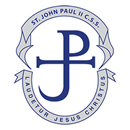
Our School
Dress Code
By choosing to attend St. John Paul II (SJPII) Catholic Secondary School, students commit to complying with the school's uniform and dress code. We believe it is important to uphold standards of modesty, neatness, cleanliness, and good taste that reflect our Catholic values.
School Uniform
The compulsory uniform components are:
Pants/Kilt
Charcoal grey pleated school dress or casual pants.
Charcoal grey flat-front school dress or casual pants.
School kilt or X-kilt (no shorter than 10cm above the knee and not to be rolled at the waist).
Golf Shirt
Short or long-sleeved white or navy school tuck-under SJPII golf shirt with contrasting stripe (navy/white) bearing the school crest.
Footwear
Plain black shoes - These must be completely black, including the stitching and soles (no accents, trim, or logos of any type in white or any other colour) and fully enclosed. Students may not wear sandals, clogs, slippers or boots.
Navy, black, or grey dress or casual socks. Girls may wear knee socks or tights. Tights must not be transparent (no pantyhose) and footless tights are not allowed.
Shorts
Navy McCarthy Uniforms shorts can only be worn during the designated times that are outlined in the school calendar as set by the principal.
Summer Uniform
The Summer Uniform can be worn from the time period indicated in the school calendar that states "Summer Uniform Begins" to "Summer Uniform Ends".
Students are allowed to wear:
Golf shirt (outlined above).
Socks - dress or casual, black, navy or grey (outlined above).
Shoes - plain black shoes (outlined above).
McCarthy Uniforms shorts (outlined above).
Optional Uniform Components
The optional uniform components are:
Navy blue zip-polo, fleece polo, v-necked long-sleeved sweater or the sleeveless vest, embroidered with the SJPII crest, available from McCarthy Uniforms. These items are not to be worn alone - they must be worn over the golf shirt outlined above.
*Please note that the Panther athletic sweater is not part of the school uniform.
McCarthy Uniforms
The school uniform components are available only from McCarthy Uniforms. Visit their online store for more information.
Dress Code Expectations
SJPII students are expected to be in full and proper uniform every school day, from the first day of school in September until the end of June examinations, unless specifically told otherwise by staff. Any student out of uniform may be sent home to change.
Students on school excursions are expected to comply with the specified dress requirements indicated on the permission form.
Civvies Days
Civvies days are held periodically. On these days, students are expected to dress in casual attire that is appropriate for a school setting (no bare backs, shoulders or mid-riffs, no décolletage, or clothing with inappropriate messages or graphics).
Uniform Requirements
Students must remain in full uniform throughout the school day, including lunch, study periods, and detentions.
Shirts and ties are no longer part of the uniform and are not permitted.
Outerwear
Coats, jackets, and other outerwear are not to be worn inside the school.
Undershirts
Only plain, all-white t-shirts (no patterns, logos, or graphics) may be worn under uniform tops and must be fully tucked in.
Long-sleeved shirts may not be worn under short-sleeved uniform items.
Belts
Belts must be plain and solid black.
Uniform Appearance Standards
Students are expected to wear their uniforms neatly and with pride:
Uniforms must not be altered.
Clothing must be properly fitted—not oversized.
Pants and kilts must be worn at the waist.
All uniform pieces must be clean and in good condition.
Excessive jewelry, large pendants, contrasting belts, sashes, or other adornments are not permitted.
Prohibited Items
Gang-related items (e.g., bandanas, grills, or any clothing/jewelry associated with gang activity) are strictly prohibited on school property and at all school-related events.
Consequences
Administrative Discretion
Decisions regarding appropriate accessories, grooming, and overall appearance are at the discretion of the school administration.
Uniform Violations
Students who arrive without full and proper uniform are in violation of the dress code and will be sent to the main office for a violation slip. These incidents are recorded, and consequences are applied accordingly and may include:
Warning
Detention
Being sent home
Suspension
The response will depend on the nature of the violation, the number of previous offences, and the specific circumstances.
Religious Accommodations
Students who wear head coverings for religious reasons may request an exemption through the administration. Approved head coverings must be solid black or navy blue.
